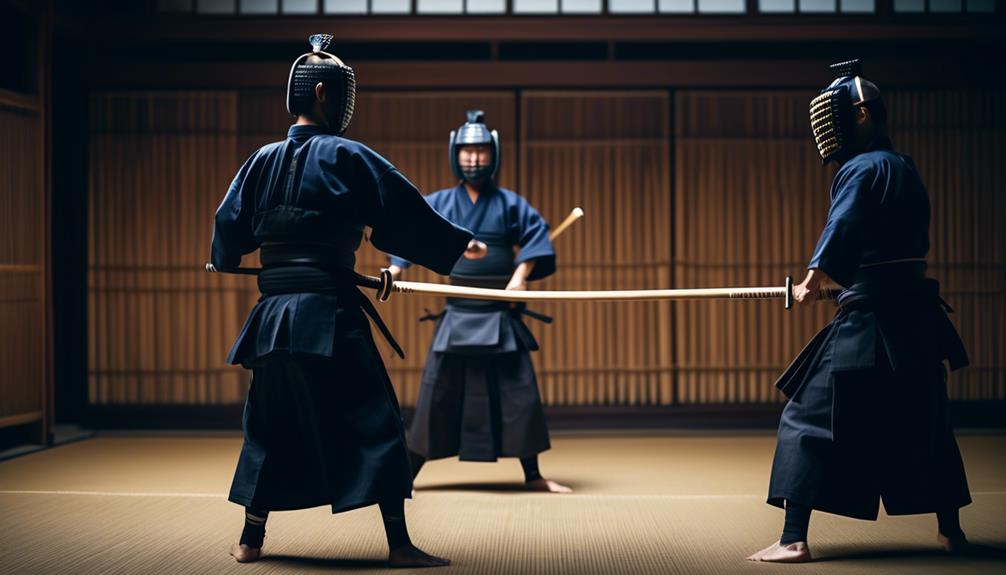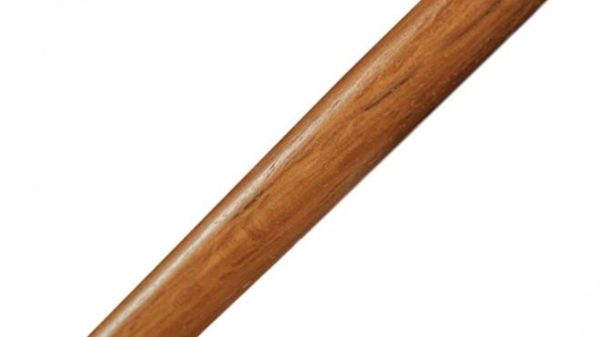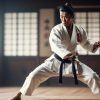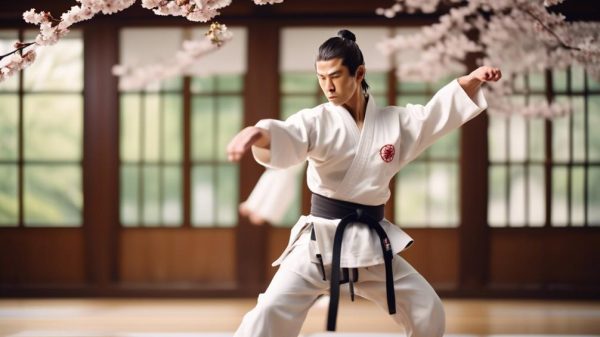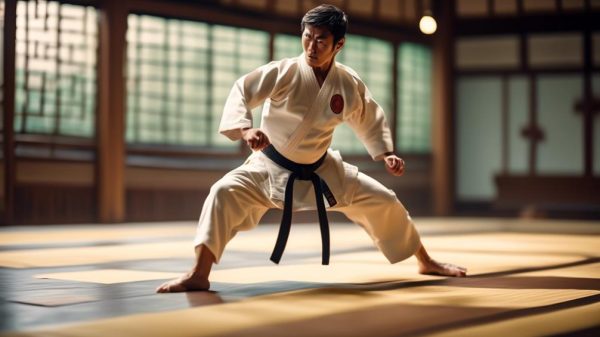Kendo is Japanese fencing with bamboo swords based on ancient samurai skills. Special training routines called kata teach kendo students proper form.
Kata means “shape” or “form” in Japanese. These practice sequences build skills step-by-step through choreographed motions. Partners work together.
Making kendo kata looks like a dance! Athletes strike, block, slash, and stab at the air – no real opponents. Going through the set motions needs precision.
Control, speed, distancing, and focus get ingrained into students through repetition. Kata drilled correctly develops balance, strength, and reactions – getting kendoka prepared for freestyle sparring matches!
Understanding Kendo Kata
Exploring Kendo Kata reveals the significance of precision and discipline, which are fundamental to this respected martial art. As partners alternate between offensive and defensive roles, the kata requires absolute accuracy.
Each movement, including footwork and sword technique, presents an opportunity to refine timing and control, distinguishing a master from a novice.
Understanding Kendo Kata goes beyond memorizing sequences; it involves embodying the spirit of Kendo as defined by the Japan Kendo Federation. Unwavering focus and deliberate movements are essential.
As one progresses, it becomes evident that the kata isn’t merely a set of prescribed motions but a dialogue between two practitioners, a conversation conveyed through the language of swords.
In competition, precision and concentration are scrutinized. The foundational katas, numbered 1 through 10, establish the basis for advanced practice.
Mastery of these forms is crucial, embedding the principles of Kendo into muscle memory and intuition. Therefore, refining each stance, perfecting each strike, and allowing the kata to reveal the path to true mastery is essential.
History of Kata
The history of Kendo Kata, also known as Ippon-me, is deeply rooted in the tradition of Japanese swordsmanship, reflecting centuries of martial refinement. As a Black Belt aspirant, practicing Kendo Kata goes beyond learning movements; it entails inheriting a legacy that transforms you into a custodian of Kendo’s time-honored techniques.
Each stance and strike in Kendo Kata is a testament to the discipline’s evolution, molding you into a practitioner capable of executing techniques with meticulous accuracy and poise. The kata’s structure fosters a martial rhythm that’s as much about mental fortitude as it’s about physical prowess.
Delving deeper into the history of kata means engaging in a living narrative that demands your utmost dedication to the art of Kendo.
Essential Equipment
To truly embody the spirit and precision of Kendo Kata, it’s essential to have the right equipment.
First and foremost, select a shinai that feels like an extension of your own arm, ensuring it’s the perfect partner for your kata practice.
Additionally, don your armor, each piece acting as a shield against strikes, and step onto the dojo floor fully prepared to succeed.
Kendo Armor Components
Enhance your Kendo experience by equipping yourself with the essential components of Kendo armor: the men, kote, do, and tare.
These meticulously crafted pieces are designed to protect you from the swift strikes of your opponent’s bamboo sword, serving as your steadfast guardians in the dojo.
As you prepare for practice, remember that embracing the Kata begins with proper equipment. These components aren’t just fabric and leather; they’re the instruments that enable you to execute your techniques with precision and safety.
- Men: Protects the head and face
- Kote: Guards the hands and forearms
- Do: Shields the torso
- Tare: Defends the waist and hips
Master your armor, follow the instructions, and refine your Kendo Kata with confidence.
Selecting the Shinai
Once you have equipped yourself with the essential armor components, your next step is to carefully choose a shinai that perfectly complements your Kendo practice.
The shinai goes beyond being just a tool; it’s an extension of your will on the dojo floor. As you strive for mastery in Kendo, the importance of selecting the right shinai can’t be overstated.
Here’s what you should take into consideration:
- Weight and Balance: Get a sense of the heft and find the balance point. Your shinai should feel like a natural extension of your arm.
- Length and Skill Level: Match the length of the shinai to your height and experience level.
- Type of Bamboo: Opt for durability and performance, as the material significantly impacts your strikes.
- Regular Inspection: Avoid accidents by checking for any damage before each practice session.
The process of selecting the right shinai is a crucial step in your Kendo journey. Choose wisely, and you’ll find your Kendo practice all the more enriching.
Fundamental Stances
Mastering the fundamental stances such as hidari jodan, migi jodan, and chudan is critical for executing Kendo Kata with precision and power. Your journey to mastery demands a relentless focus on these foundational positions.
The chudan stance, central to your repertoire, offers a poised and balanced posture from which to mount both offensive and defensive maneuvers. It’s the fortress of your technique, shielding you as you anticipate your opponent’s next move.
Transitioning into the jodan position, whether left (hidari) or right (migi), requires unwavering concentration.
The elevation of your shinai in the jodan stance signals your readiness to strike with decisive force. This position isn’t just a physical posture but a reflection of your mental preparedness and intent.
Remember, your footwork and posture aren’t mere details; they’re the core of your balance and control.
Each time you assume a stance, you’re not just going through motions; you’re etching muscle memory, honing your body to react with the sharpness of a katana’s edge.
Embrace the repetition, for it’s in this discipline that the essence of Kendo’s fundamental stances transforms from mere technique to an extension of your will. Achieve this, and you won’t only perform Kata but embody it.
Step-by-Step Movements
Stepping into the world of Kendo Kata, you’ll commence with Uchidachi assuming the aggressive hidari jodan stance, while you, as Shidachi, mirror the intent with your migi jodan, both poised for the intricate dance of blades that follows.
The step-by-step movements of this kata are pivotal, as they lay the groundwork for your future in Kendo.
To master these movements, consider the following:
- Positioning: Every step and turn is a deliberate act, ensuring that you’re always in the optimal position to strike or defend.
- Precision: Each cut and parry must be executed with surgical accuracy, reflecting the discipline of the Kendo practitioner.
- Timing: The rhythm of your steps and strikes must harmonize with your opponent’s movements, embodying the ebb and flow of a real combat scenario.
- Zanshin: Maintain awareness and readiness throughout the kata; your spirit should never waver.
As Uchidachi begins the kata, you’ll follow, your actions a mirror yet a counter to theirs. Each advance and retreat is a conversation in physical form, a lesson in control and intent. Embody these teachings, for they’re the essence of Kendo’s way of the sword.
Common Mistakes to Avoid
In Kendo Kata, it’s essential to maintain precise footwork and a strong foundation.
Timing your strikes perfectly is crucial for achieving the level of skill that sets masters apart.
Keep your focus sharp and execute each movement with the precision of a skilled craftsman.
Incorrect Footwork Execution
To execute Kendo Kata with the necessary grace and power, it’s crucial to avoid common footwork mistakes that can disrupt the harmony and precision between Uchidachi and Shidachi. Correct footwork subtleties play a pivotal role in mastering this art form. Here are some key errors to steer clear of:
- Overstepping, as it can lead to a loss of balance and control.
- Hesitant or dragging feet, which can undermine the kata’s rhythm.
- Incorrect Maai (spacing), affecting the timing of attacks and defenses.
- Failing to mirror your partner’s movements, breaking the kata’s synchronicity.
Impeccable footwork forms the foundation upon which Kendo Kata’s elegance is built. Focus on the accuracy and timing of each step to demonstrate your commitment to this discipline.
Inaccurate Strike Timing
Learning the precise timing of strikes is crucial for excelling in Kendo Kata, ensuring that each movement is powerful and effective. Incorrect strike timing not only weakens your technique but also provides your opponent with an opportunity to counter.
During kata instruction, focus on intentional and mindful practice. Each strike should demonstrate your control and understanding of rhythm. Rushing or dragging your movements leads to inaccurate strike timing, compromising the integrity of the kata.
Refine your skills by paying close attention to the timing of each action. Precision in timing is essential; it forms the core of your proficiency. Regular, mindful practice is your path to flawless execution. Embrace the discipline required to correct this common mistake, and your strikes will resound with unmistakable accuracy.
Practice Drills and Tips
Tips for Improving Kendo Kata Practice
Refining Kendo kata practice requires unwavering dedication and a commitment to perfecting every aspect of your technique. Here are some essential tips for honing your skills:
- Suburi Drills: Focus on accuracy before speed by refining your sword swings with repetitive motions.
- Footwork Exercises: Strengthen your foundation by practicing suri-ashi and fumikomi-ashi to improve your foot movements and stability.
- Kata Pairing: Sharpen your awareness and control by pairing up with a skilled practitioner to mirror and critique each other’s kata.
- Mental Training: Enhance focus by incorporating meditation, allowing for a deeper connection between mind and body during kata execution.
Every strike in Kendo kata is a display of expertise. Challenge both your physical and mental prowess with practice drills to embody the spirit of Kendo.
Embrace the rigorous journey of refinement, for it’s in the relentless pursuit of perfection that a true Kendoka is forged.
Progressing Beyond Kata
Progressing Beyond Kata in Kendo signifies a significant advancement in refining swordsmanship. The focus shifts towards precision, timing, and control while delving into the profound aspects of the martial art’s philosophy and technique. Mastery of the fundamental movements lays the groundwork for further development. Additional kata instruction immerses practitioners in a clearer path towards expertise, pushing them to move beyond mere formality. This integration involves intricate footwork and complex sequences, challenging both body and mind.
Advancing beyond Kata is a transformative journey that connects practitioners with Kendo’s deeper spiritual roots. It involves honing not only technique but also the inner strength required for true mastery. Each new kata encountered builds upon the last, demanding greater understanding and flawless execution.
As practitioners delve into higher-level katas, the subtleties of advanced techniques and strategies unfold. These elements of Kendo Kata aren’t just physical motions; they’re conversations with history, art, and the essence of the warrior spirit. The journey through Kendo is endless, representing a continuous refinement of skill and self. Embracing the rigors of progression is crucial, as each step taken is a stride toward becoming a consummate Kendoka.
Frequently Asked Questions
How Many Kendo Katas Are There?
Master the tradition of Kendo with 10 unique katas, each offering distinct origins and benefits. Regular practice is key to honing your skills, regardless of the equipment used. Embrace the precision of each kata as it paves the way to mastery in your Kendo journey.
What Is Kendo Grading?
Kendo grading serves as a crucial step on your journey toward mastery, as it evaluates your skills, knowledge, and spirit against strict promotion criteria within the Dan system. This assessment holds significant importance in your martial arts progression, highlighting the key role it plays in your development.

